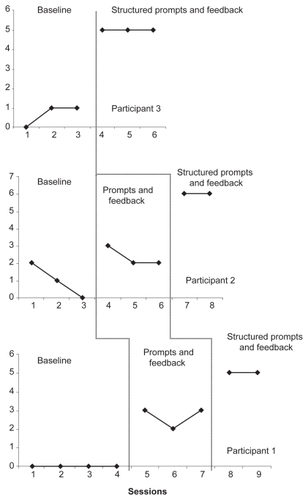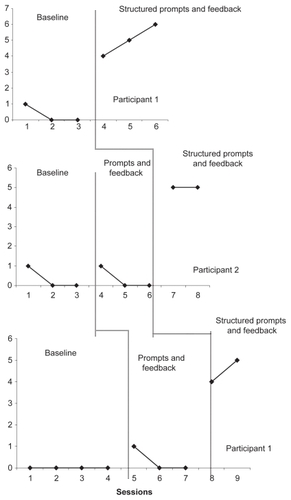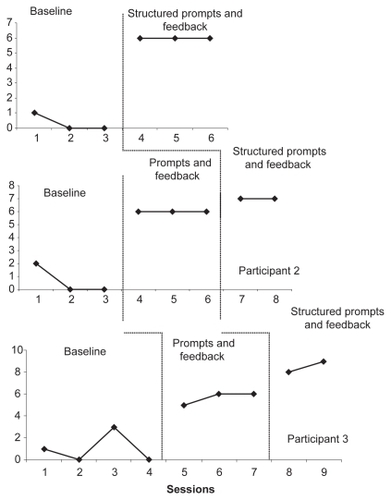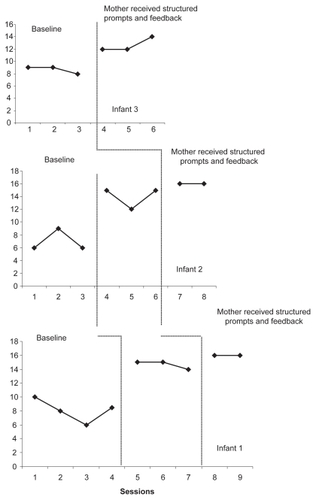Abstract
It has been documented that adolescent mothers are less verbally and emotionally responsive in their interactions with their children compared to adult mothers. These less than optimal adolescent mother/infant interactions have been found to affect the child’s healthy growth and development. This small study aimed to identify and characterize the frequency of verbal behaviors exhibited in the infant/adolescent mother dyad during feeding sessions during a baseline phase of a study that employed single subject methodology. An individualized bug-in-the-ear feedback and prompting parent training model was instituted in the intervention phase of the study to improve the frequency and quality of infant-mother interaction. Results of the study clearly revealed low frequency of verbal interaction in the baseline phase. After a structured prompting intervention was instituted there were positive effects in the mother’s behaviors which in turn positively impacted infant behavior.
Introduction
Previous studies have shown that adolescent mothers are less verbal to their infants compared to older mothers. CitationPomerleau and colleagues (2003) found that teenage mothers vocalized less compared with adult mothers, and they found that their infants obtained lower mental scores at 6 months. CitationLacroix and colleagues (2002) also found differences in utterance properties in adolescent mothers, with the use of more controlling/directive utterances. Recent research has documented that adolescent mothers are also less likely to show heightened/selective responses to infant cues and tended to show less attentive responses to infants. For example, CitationGiardino and colleagues (2008) found that, unlike adult mothers, adolescent mothers did not show an “alerted” pattern of heart rate or cortisol response to infant cues. Additional studies have established the importance of interactions between a mother and her infant as crucial for optimal child development (CitationBeckwith and Cohen 1984; CitationOlson et al 1992). Maternal behaviors including mother’s gaze, physical interaction and vocalizations have been found to be related with several outcome measures, including cognitive, language and interactive performances (CitationOlson et al 1992). More recent studies, including CitationPomerleau and colleagues (2003), have found that infants of adolescent mothers who vocalized less obtained lower mental scores at 6 months. Further, CitationOxford and Spieker (2006) revealed that having a poor language-learning home environment was associated with children’s low language scores. Much research conducted in the last 30 years have documented that children of adolescent mothers do more poorly on cognitive tests and measures of school achievement than children of adult mothers (CitationOxford and Spieker 2006). The effects have been found to be especially persistent for tests of verbal ability and vocabulary (CitationOxford and Spieker 2006).
Such documented studies support the importance of interventions such as parent training to improve the quality and frequency of verbal behaviors of the adolescent mother to her infant. From a behavior analyst standpoint, verbal activity can be described as the result of environmental contingencies, particularly audience response (CitationSkinner 1957). Thus, it can be postulated that adolescent mothers do not communicate with their infants, at least in part because it is unlikely that they will get a reinforcing response. It is thus imperative that we continue to explore parent training approaches that are most effective in promoting positive interaction between the adolescent mother/infant dyad.
The purpose of this study was to investigate whether a prompting intervention delivered via a bug-in-the-ear feedback (a wireless earphone) using positive reinforcement could improve verbal behaviors in the adolescent mother/infant dyad during feeding sessions.
Method
Design
Single subject design was employed in this study. The design derived from behavior analysis, is a research design that provides an experimental model for the study of individuals over time. The design is a clinically viable, controlled experimental approach to the study of a single case or several subjects, and the flexibility to observe change under ongoing treatment (CitationPortney and Watkins 2000).
Participants and setting
After obtaining approval from the affiliate university Institutional Review Board (IRB) and the local Department of Health IRB, three adolescent mothers and their infants were recruited through referrals from a local public health agency. Inclusion criteria for participating in the study were based on conditions that were optimal for mother/infant interactions and also based on conditions that minimized the risk of the impact of confounding variables such as age, racial and cultural differences on interaction behaviors. Thus, mothers recruited: (1) were 15 years old, (2) African American, (3) and had no previous parenting experience, (4) had a vaginal delivery, and (5) were in good mental and physical health as determined by their health care provider. Inclusion criteria for the infants were (1) thirty six weeks gestation or greater (2) no congenital abnormalities (3) between the ages of six weeks and six months (4) formula-fed and (5) in good general health as determined by their health care provider.
Formula feeding was used as an inclusion criteria to minimize the possible psychological discomfort associated with videotaping in this population, particularly when breast feeding. All sessions were conducted at the participant’s home. Verbal behaviors for this paper included frequency of mothers’ comments on hunger cues, frequency of mothers’ use of positive statements and the frequency of mothers’ use of multiple words. These behaviors were selected after the review of existing mother/infant attachment literature.
Procedure
A nonconcurrent multiple baseline design across participants was used. The demonstration of experimental control in the multiple baseline design depends upon approximately equal effects of the treatment being observed with each baseline (CitationBailey and Burch 2002). Therefore, baseline videotaping was done at the 1 pm feeding of the infants of all three 15-year-old mothers. After baseline stability was reached, the intervention phase was instituted but staggered, several days to several weeks apart, across participants due to their different schedules and availability. A modified intervention was instituted for the first two participants after only subtle changes in target behaviors were observed after the first intervention was instituted. The third participant received the modified intervention only (There were a total of nine sessions for Participant 1, eight sessions for Participant 2, and six for Participant 3). At the conclusion of the study all adolescent mothers received a gift certificate of $25–$35 (depending on the number of sessions).
After baseline stability was reached, an individualized intervention delivered via a bug-in-the-ear feedback was designed and instituted based on the occurrence or nonoccurrence of verbal behaviors that were identified during the baseline phase. The intervention phase was staggered, several days to several weeks apart, across participants due to their different schedules and availability. All sessions were completed within a two-month time frame for each participant ().
Table 1 Videotaping schedule of participants
Coding of videotapes
Three independent observers coded target verbal behaviors of the videotaped sessions. The time interval coding method was used for the target behavior. Infant feeding for participants lasted between 6 1/2 minutes and 11 minutes. Thus, 6 minute sessions of each videotaped interaction were coded and frequencies of occurrences of behaviors were recorded every 20 seconds.
Bug-in-the-ear equipment
In this study, two Motorola cell phones with bluetooth wireless technology and paging capabilities were used. The investigator called the participants on the cell phone at the beginning of the intervention session from a different room/location and kept the line open to deliver the prompts. The bug-in-the-ear used was a wireless bluetooth headset.
Bug-in-the-ear prompting and feedback
The first intervention involved the investigator’s randomly interjecting several prompts for desired verbal behaviors and providing reinforcement such as “great,” or “good job” when the desired behaviors were exhibited via the bug-in-the-ear feedback. After several sessions with this intervention with the first two participants, very subtle changes in target verbal behavior were noticed.
During debriefing after the first intervention, the participants reported that they had difficulty formulating positive statements about their infants because they were not clear what that meant. Thus the language used in delivering the prompts to elicit that target behavior was simplified and specific examples of the verbal target behavior were also given. For example, the investigator would prompt the mother via the bug-in-the-ear by saying something such as “tell him how cute he is or how good an eater he is.” The intervention was modified to be structured, where prompts, cues and reinforcements were given in sequence, followed by reinforcement for each exhibited target behavior. For example, when the mother began to feed the infant, the investigator would prompt the participant via the bug-in-the-ear device by saying something such as “remember to talk to him (the infant) about how hungry he is acting.” The investigator would further cue the mother by saying, “talk to him some more about how hungry he is and how good the milk tastes.” When the behavior of commenting on infant’s hunger, for example, was exhibited, the investigator provided reinforcement using language such as “great job!”
This modified intervention incorporating participant feedback was instituted with all three participants and found to produce a significant change in target behaviors. As a result of the first two participants’ positive response to the modified intervention, Participant 3 received this modified intervention only, after her baseline stability was achieved.
Results
Coding of six minute feeding sessions revealed that in the baseline phase of the study, all three participants exhibited very low frequencies of verbal communication to their infants. Pictorial representation of the prompting interventions for the low frequency communication target behaviors demonstrated that the behaviors appeared to increase only after the second prompting feedback intervention (–). The change in verbal behavior was immediate in nearly every case. This change had a clear effect on the infants’ interactive behavior with the mother as well ().
Discussion
The baseline phase of the study clearly identified the low frequency and nonoccurrence of verbal behaviors that required intervention. After the intervention was instituted in the second phase of the study there were positive effects in the mother’s behaviors which in turn positively impacted infant behavior. This was particularly notable in the area of the infant responding to the mother and was clearly demonstrated by the increase in the frequency at which the infant looked in the mothers’ direction in the six minute coded sessions. Although all three infants intermittently looked in the direction of their mother in all feeding sessions in the baseline phase, there was an increase in the frequency of this behavior with the prompting interventions. The findings clearly demonstrate the importance of verbal communication in mother/infant interactions and also suggest that prompting interventions with adolescent mothers may need to be structured. Further, the study reveals that reinforcement can increase verbal behaviors in the adolescent mother/infant dyad which can result in an improvement in interaction behaviors between mother and infant.
Findings from this study extend and strengthen previous research in this area that has shown that adolescent mothers are less verbal to their infants (CitationBrooks-Gunn and Chase-Landale 1995; CitationCulp et al 1996; CitationPomerleau et al 2003). Additional studies have established the importance of interactions between a mother and her infant as crucial for optimal child development (CitationSroufe 1985; CitationOlson et al 1992; CitationOxford and Spieker 2006). Infants exposed to greater verbal stimulation have been found to be more likely to have better verbal comprehension later in life (CitationOlson et al 1992; CitationLacroix et al 2002). The findings of this study support the importance of interventions such as parent training to improve the quality and frequency of verbal behaviors, particularly as they relate to adolescent mother and her infant. Improvement in these mother/infant behaviors ultimately can have a positive impact on the child’s development.
Implications
The findings of this study demonstrate that a prompting intervention using a bug-in-the-ear feedback can increase the frequency of verbal behaviors in the adolescent mother/infant dyad which according to the literature can ultimately have a positive impact on the infant’s development. Although the intervention was successful in this study, it is important to indicate that the bug-in-the-ear-feedback intervention was a labor-intensive approach in changing mother/infant interaction behaviors. Yet it can not be assumed that the intervention implemented in the intervention phases was comprehensive enough to maintain long term optimal mother/infant interaction behaviors.
Thus, further research is warranted on exploring the best approaches in changing these rather complex and difficult behaviors. Since adolescents respond well to technology, further research can explore how technological approaches such as tele-health or computerized prompting can be used as a large scale intervention approach to improve interaction behaviors between the adolescent mother and her infant.
Limitations of the study and recommendations
Several limitations of the study that suggest avenues for future research warrant comment. These limitations are presented below, including recommendations for future research.
Only three adolescent mother/infant dyads participated in this study. It would be worthwhile to replicate this work with a larger sample.
The three adolescent mother/infant dyads in this study were all African American and of similar sociocultural backgrounds. It would be beneficial if future research was conducted on participants from different racial and sociocultural backgrounds. Comparisons could provide valuable information on whether race and culture influence adolescent mother/infant interaction behaviors.
The Investigator videotaped mother/infant interaction in the family’s home during each home visit. Although the Investigator waited in another room while the videotaping occurred, there is no information regarding what effect if any, the Investigator’s presence in the home may have had on the participants’ behavior.
Although all sessions were completed within two months, there still is the possibility of the change in mother/infant interaction being influenced by normal development and experience. It would be beneficial to replicate this study using infants of the same age.
As a result of the risk of attrition, phases of this study were not prolonged. However, it cannot be assumed that the intervention implemented in the intervention phases was comprehensive enough to maintain long-term optimal mother/infant interaction behaviors. Thus, a solution would be to extend the intervention phases. Additionally, further research is needed to determine the amount of parent training that is required to maintain optimal mother/infant interactions in the adolescent mother/infant dyad.
Disclosure
The authors report no conflicts of interest in this work.
References
- BaileyJSBurchMR2002Research methods in applied behavior analysisThousand Oaks, CASage Publications, Inc
- BeckwithLCohenS1984Home environment and cognitive competence in preterm children during the first five yearsGottfriedAWHome environment and early cognitive developmentNew YorkAcademic Press23573
- Brooks-GunnJChase-LansdaleP1995Adolescent parenthood and parenting: development in contextBornsteinMHHandbook of parentingNew JerseyErlbaum1349
- CulpRCulpAOsofskyJ1991Adolescent and older mothers’ interaction patterns with their six month old infantsJ Adolesc141952001918520
- GiardinoJGonzalezASteinerM2008Effects of motherhood on physiological and subjective responses to infant cries in teenage mothers: a comparison with non-mothers and adult mothersHorm Behav531495818076883
- LacroixVPomerleauAMalcuitG2002Properties of adult and adolescent mothers’ speech, children’s verbal performance and cognitive development in different socioeconomic groups: A longitudinal studyFirst Language2217396
- OlsonSBatesJKaskieB1992Caregiver infant interaction antecedents of children’s school-age cognitive abilityMerrill Palmer Q3830930
- O’ReillyMFRenzagliaALeeS1994An analysis of acquisition, generalization, and maintenance of systematic instruction competence by preservice teachers using behavioral supervision techniquesEducation and Training in Mental Retardation and Developmental Disabilities292233
- OxfordMSpiekerS2006Preschool language development among children of adolescent mothersJ Appl Dev Psychology2716582
- PomerleauAScuccimarriC2003Mother-infant behavioral interactions in teenage and adult mothers during the first six months postpartum: Relations with infant developmentInfant Ment Health J24495509
- PortneyLWatkinsM2000Foundations of clinical research: Applications to practiceNew JerseyPrentice-Hall
- SkinnerBF1957Verbal behaviorNew YorkAppleton-Century-Crofts
- SroufeLA1985Attachment classification from the perspective of infant-caregiver relationships and infant temperamentChild Dev561143987395



